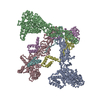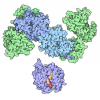[English] 日本語
 Yorodumi
Yorodumi- PDB-8puv: Trimeric prM/E spike of Tick-borne encephalitis virus immature pa... -
+ Open data
Open data
- Basic information
Basic information
| Entry | Database: PDB / ID: 8puv | |||||||||
|---|---|---|---|---|---|---|---|---|---|---|
| Title | Trimeric prM/E spike of Tick-borne encephalitis virus immature particle | |||||||||
 Components Components |
| |||||||||
 Keywords Keywords | VIRUS / immature particle / tick-borne / flavivirus / spike trimer | |||||||||
| Function / homology |  Function and homology information Function and homology informationflavivirin / symbiont-mediated suppression of host JAK-STAT cascade via inhibition of STAT2 activity / symbiont-mediated suppression of host JAK-STAT cascade via inhibition of STAT1 activity / viral capsid / double-stranded RNA binding / nucleoside-triphosphate phosphatase / clathrin-dependent endocytosis of virus by host cell / mRNA (guanine-N7)-methyltransferase / methyltransferase cap1 / methyltransferase cap1 activity ...flavivirin / symbiont-mediated suppression of host JAK-STAT cascade via inhibition of STAT2 activity / symbiont-mediated suppression of host JAK-STAT cascade via inhibition of STAT1 activity / viral capsid / double-stranded RNA binding / nucleoside-triphosphate phosphatase / clathrin-dependent endocytosis of virus by host cell / mRNA (guanine-N7)-methyltransferase / methyltransferase cap1 / methyltransferase cap1 activity / mRNA 5'-cap (guanine-N7-)-methyltransferase activity / RNA helicase activity / protein dimerization activity / host cell perinuclear region of cytoplasm / symbiont-mediated suppression of host innate immune response / host cell endoplasmic reticulum membrane / RNA helicase / symbiont-mediated suppression of host type I interferon-mediated signaling pathway / symbiont-mediated activation of host autophagy / RNA-directed RNA polymerase / serine-type endopeptidase activity / viral RNA genome replication / RNA-directed RNA polymerase activity / fusion of virus membrane with host endosome membrane / viral envelope / virion attachment to host cell / host cell nucleus / virion membrane / structural molecule activity / ATP hydrolysis activity / proteolysis / extracellular region / ATP binding / metal ion binding / membrane Similarity search - Function | |||||||||
| Biological species |  Tick-borne encephalitis virus Tick-borne encephalitis virus | |||||||||
| Method | ELECTRON MICROSCOPY / single particle reconstruction / cryo EM / Resolution: 4 Å | |||||||||
 Authors Authors | Fuzik, T. / Plevka, P. / Smerdova, L. / Novacek, J. | |||||||||
| Funding support |  Czech Republic, 2items Czech Republic, 2items
| |||||||||
 Citation Citation |  Journal: Sci Adv / Year: 2024 Journal: Sci Adv / Year: 2024Title: The structure of immature tick-borne encephalitis virus supports the collapse model of flavivirus maturation. Authors: Maria Anastasina / Tibor Füzik / Aušra Domanska / Lauri Ilmari Aurelius Pulkkinen / Lenka Šmerdová / Petra Pokorná Formanová / Petra Straková / Jiří Nováček / Daniel Růžek / ...Authors: Maria Anastasina / Tibor Füzik / Aušra Domanska / Lauri Ilmari Aurelius Pulkkinen / Lenka Šmerdová / Petra Pokorná Formanová / Petra Straková / Jiří Nováček / Daniel Růžek / Pavel Plevka / Sarah Jane Butcher /   Abstract: We present structures of three immature tick-borne encephalitis virus (TBEV) isolates. Our atomic models of the major viral components, the E and prM proteins, indicate that the pr domains of prM ...We present structures of three immature tick-borne encephalitis virus (TBEV) isolates. Our atomic models of the major viral components, the E and prM proteins, indicate that the pr domains of prM have a critical role in holding the heterohexameric prM3E3 spikes in a metastable conformation. Destabilization of the prM furin-sensitive loop at acidic pH facilitates its processing. The prM topology and domain assignment in TBEV is similar to the mosquito-borne Binjari virus, but is in contrast to other immature flavivirus models. These results support that prM cleavage, the collapse of E protein ectodomains onto the virion surface, the large movement of the membrane domains of both E and M, and the release of the pr fragment from the particle render the virus mature and infectious. Our work favors the collapse model of flavivirus maturation warranting further studies of immature flaviviruses to determine the sequence of events and mechanistic details driving flavivirus maturation. | |||||||||
| History |
|
- Structure visualization
Structure visualization
| Structure viewer | Molecule:  Molmil Molmil Jmol/JSmol Jmol/JSmol |
|---|
- Downloads & links
Downloads & links
- Download
Download
| PDBx/mmCIF format |  8puv.cif.gz 8puv.cif.gz | 313.6 KB | Display |  PDBx/mmCIF format PDBx/mmCIF format |
|---|---|---|---|---|
| PDB format |  pdb8puv.ent.gz pdb8puv.ent.gz | 250.4 KB | Display |  PDB format PDB format |
| PDBx/mmJSON format |  8puv.json.gz 8puv.json.gz | Tree view |  PDBx/mmJSON format PDBx/mmJSON format | |
| Others |  Other downloads Other downloads |
-Validation report
| Summary document |  8puv_validation.pdf.gz 8puv_validation.pdf.gz | 1.4 MB | Display |  wwPDB validaton report wwPDB validaton report |
|---|---|---|---|---|
| Full document |  8puv_full_validation.pdf.gz 8puv_full_validation.pdf.gz | 1.5 MB | Display | |
| Data in XML |  8puv_validation.xml.gz 8puv_validation.xml.gz | 61.2 KB | Display | |
| Data in CIF |  8puv_validation.cif.gz 8puv_validation.cif.gz | 91.5 KB | Display | |
| Arichive directory |  https://data.pdbj.org/pub/pdb/validation_reports/pu/8puv https://data.pdbj.org/pub/pdb/validation_reports/pu/8puv ftp://data.pdbj.org/pub/pdb/validation_reports/pu/8puv ftp://data.pdbj.org/pub/pdb/validation_reports/pu/8puv | HTTPS FTP |
-Related structure data
| Related structure data |  17947MC  8ppqC M: map data used to model this data C: citing same article ( |
|---|---|
| Similar structure data | Similarity search - Function & homology  F&H Search F&H Search |
- Links
Links
- Assembly
Assembly
| Deposited unit | 
|
|---|---|
| 1 | x 60
|
- Components
Components
| #1: Protein | Mass: 53572.297 Da / Num. of mol.: 3 / Source method: isolated from a natural source / Source: (natural)  Tick-borne encephalitis virus / Strain: Neudoerfl / References: UniProt: P14336 Tick-borne encephalitis virus / Strain: Neudoerfl / References: UniProt: P14336#2: Protein | Mass: 18076.670 Da / Num. of mol.: 3 / Source method: isolated from a natural source / Source: (natural)  Tick-borne encephalitis virus / Strain: Neudoerfl / References: UniProt: P14336 Tick-borne encephalitis virus / Strain: Neudoerfl / References: UniProt: P14336#3: Sugar | Has ligand of interest | Y | Has protein modification | Y | |
|---|
-Experimental details
-Experiment
| Experiment | Method: ELECTRON MICROSCOPY |
|---|---|
| EM experiment | Aggregation state: PARTICLE / 3D reconstruction method: single particle reconstruction |
- Sample preparation
Sample preparation
| Component | Name: Tick-borne encephalitis virus / Type: VIRUS Details: Immature particles produced using tissue cell cultures Entity ID: #1-#2 / Source: NATURAL | ||||||||||||||||||||
|---|---|---|---|---|---|---|---|---|---|---|---|---|---|---|---|---|---|---|---|---|---|
| Molecular weight | Experimental value: NO | ||||||||||||||||||||
| Source (natural) | Organism:  Tick-borne encephalitis virus / Strain: Neudoerfl Tick-borne encephalitis virus / Strain: Neudoerfl | ||||||||||||||||||||
| Details of virus | Empty: NO / Enveloped: YES / Isolate: STRAIN / Type: VIRION | ||||||||||||||||||||
| Virus shell | Name: immature particle / Diameter: 600 nm | ||||||||||||||||||||
| Buffer solution | pH: 8.5 | ||||||||||||||||||||
| Buffer component |
| ||||||||||||||||||||
| Specimen | Conc.: 2 mg/ml / Embedding applied: NO / Shadowing applied: NO / Staining applied: NO / Vitrification applied: YES Details: purified immature particles of Tick-borne encephalitis virus | ||||||||||||||||||||
| Vitrification | Instrument: FEI VITROBOT MARK IV / Cryogen name: ETHANE / Humidity: 100 % / Chamber temperature: 280 K |
- Electron microscopy imaging
Electron microscopy imaging
| Experimental equipment |  Model: Titan Krios / Image courtesy: FEI Company |
|---|---|
| Microscopy | Model: FEI TITAN KRIOS |
| Electron gun | Electron source:  FIELD EMISSION GUN / Accelerating voltage: 300 kV / Illumination mode: FLOOD BEAM FIELD EMISSION GUN / Accelerating voltage: 300 kV / Illumination mode: FLOOD BEAM |
| Electron lens | Mode: BRIGHT FIELD / Nominal magnification: 105000 X / Nominal defocus max: 3000 nm / Nominal defocus min: 1000 nm / Cs: 2.7 mm / C2 aperture diameter: 30 µm / Alignment procedure: COMA FREE |
| Specimen holder | Cryogen: NITROGEN / Specimen holder model: FEI TITAN KRIOS AUTOGRID HOLDER |
| Image recording | Average exposure time: 2 sec. / Electron dose: 40 e/Å2 / Detector mode: INTEGRATING / Film or detector model: GATAN K3 BIOQUANTUM (6k x 4k) / Num. of grids imaged: 1 / Num. of real images: 11246 Details: collected in movie mode total 40 fractions per micrograph |
- Processing
Processing
| EM software |
| |||||||||||||||||||||||||||||||||||||||||||||
|---|---|---|---|---|---|---|---|---|---|---|---|---|---|---|---|---|---|---|---|---|---|---|---|---|---|---|---|---|---|---|---|---|---|---|---|---|---|---|---|---|---|---|---|---|---|---|
| CTF correction | Type: PHASE FLIPPING AND AMPLITUDE CORRECTION | |||||||||||||||||||||||||||||||||||||||||||||
| Particle selection | Num. of particles selected: 1639578 Details: picked as sub-particles form original whole immature particle reconstruction | |||||||||||||||||||||||||||||||||||||||||||||
| Symmetry | Point symmetry: C1 (asymmetric) | |||||||||||||||||||||||||||||||||||||||||||||
| 3D reconstruction | Resolution: 4 Å / Resolution method: FSC 0.143 CUT-OFF / Num. of particles: 552993 / Algorithm: FOURIER SPACE / Symmetry type: POINT | |||||||||||||||||||||||||||||||||||||||||||||
| Atomic model building | Protocol: RIGID BODY FIT / Space: REAL / Target criteria: CC Details: inital alhafol generated model was rigidbody fitted into map by Chimera, manually adjusted in Coot and realspace refined in Phenix | |||||||||||||||||||||||||||||||||||||||||||||
| Atomic model building | Source name: AlphaFold / Type: in silico model | |||||||||||||||||||||||||||||||||||||||||||||
| Refine LS restraints |
|
 Movie
Movie Controller
Controller






 PDBj
PDBj




